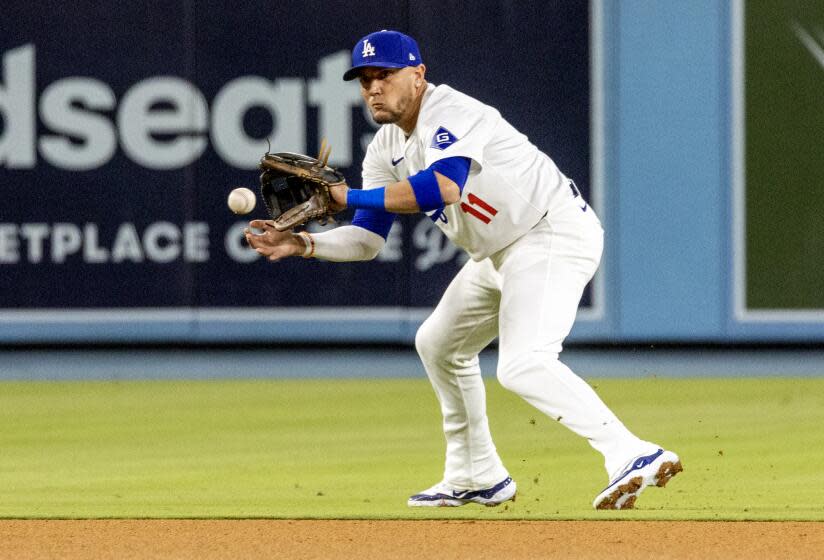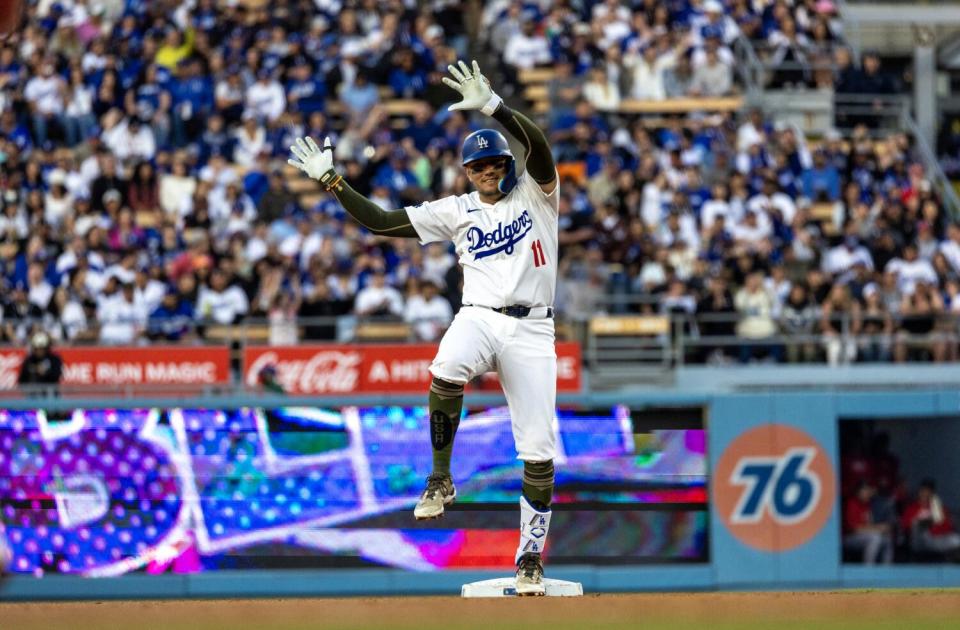Even with reduced playing time, Dodgers' Miguel Rojas has become more valuable than ever

The defensive contributions of Miguel Rojas have been notable considering how little he has played this season, the Dodgers utility man accumulating two defensive runs saved in just 62 innings at second base and one defensive run saved in just 118 innings at shortstop, according to Fangraphs.
But there are no advanced metrics to quantify the impact and influence Rojas has had on fellow infielders Mookie Betts, Gavin Lux and Max Muncy, who have combined for 13 defensive runs saved entering Friday night’s game against the Colorado Rockies.
“If there was, I want to know the number,” Dodgers third-base coach Dino Ebel said, “because it would be as high on the chart as I think you could get.”
Rojas is 35 and nearing the end of a big-league career in which he has spent 11 years as a slick-fielding, light-hitting infielder. The Dodgers’ regular shortstop in 2023, Rojas has played a part-time role this season, starting just 23 of 58 games entering the weekend.
But a significant reduction in playing time hasn’t diminished his value. Rojas is on the infield three to four hours before each game, tutoring teammates on the finer points of glove work and positioning, charging slow rollers and back-handing hard grounders, and the proper technique, footwork and arm angles for double-play feeds and pivots.
Read more: Will Smith homers twice as Dodgers complete sweep of Mets with rout
Much of Rojas’ early work is with Betts, the six-time Gold Glove Award-winning right fielder who is playing shortstop full time this season for the first time since high school and entered Friday with four defensive runs saved, tied for fourth among major leaguers at his position.
“He’s made the process tough, but fun,” Betts said of Rojas. “When you have a resource like that, it makes things a little bit easier.”
Rojas has also worked extensively with Lux, who ranks third among big league second basemen with five defensive runs saved, and Muncy, who accumulated four defensive runs saved, tied for second among major league third basemen, before going on the injured list because of a rib-cage strain on May 17.
While the offense sputtered for two weeks before breaking out in a three-game sweep of the New York Mets this past week and an injury-plagued bullpen has been spotty at times, defense has been a season-long constant.
The Dodgers entered Friday with a major league-best 35 defensive runs saved, according to Sports Info Solutions, and had converted 77.9% of ground balls into outs, the best rate in the league.
“It’s unbelievable what he’s done — he’s putting all this hard work in, not just for himself, but for the team,” Ebel said of Rojas. “He’s given Mookie advice, shown him routines … I couldn’t ask for anything better from my end, because player-to-player is always the best thing, especially when an elite defender like Miggy is giving Mookie tips.
“They’ll listen to coaches, and I can stay on them about making sure they get their work in and the footwork and throwing through the base, blah-blah-blah. But when a great defender like Miggy is putting all that he has into Mookie, it means so much more player-to-player than coach-to-player.”
Rojas’ contract includes a $5-million option for 2025 that he hopes the team will exercise. After that, he could transition to a big-league coaching role.
“I understand what part of my career I’m in right now — I might be playing for a few more years and then I’m going to have to do something after baseball,” Rojas said. “I’m embracing this opportunity to actually start coaching a little bit with my teammates. That way, I can prepare myself for what’s coming next.”
Rojas is keeping his post-playing-career options open. A regular co-host on the Chris Rose Rotation podcast, the Venezuelan native might explore a bilingual broadcasting job in Los Angeles or Miami, where he lives during the off-season.
He’s trying to learn more about analytics and how they are integrated into game-planning, and how general managers put teams together over the winter in preparation for a possible front-office role.
Read more: Dodgers look like old selves in doubleheader sweep of Mets
“I feel like there’s many possibilities, but my main focus and my main goal is to manage at the big-league level,” Rojas said. “I don’t know how I’m gonna get there.”
Dodgers manager Dave Roberts could provide a road map. He spent 10 years (1999-2008) as a big-league outfielder before working as a studio analyst and color commentator for Boston Red Sox telecasts. He spent five years (2011-15) as a San Diego Padres coach before becoming the Dodgers manager in 2016.
Rojas is focused primarily on playing for now, but the extra time on the bench has allowed him to keep one eye on Roberts.
“I’m trying to be an extension of the manager,” Rojas said. “I’m trying to read the game alongside him, figure out what he wants to do, when he’s gonna put me in the game, when he’s gonna use Kiké [Hernández] and [Chris Taylor]. When you have a right-hander on the mound and a lefty lineup, when do you want to make a move?
“Looking a little bit ahead of the game, knowing the [opposing] closer is right-handed, so you don’t want to bring your right-handed bats in too early, how to manage a bullpen. Those are the things I’m kind of learning, not just from Doc, but from the organization.”
Ebel has no doubt Rojas would thrive in a coaching role “because of his love of the game,” he said. “He’s always willing to learn.”
Ebel, 58, played six minor league seasons, spent 14 years as a minor league coach and manager, 13 years as an Angels third-base coach and bench coach and is in his sixth year as the Dodgers’ third-base coach. Though he never played in the big leagues, Ebel sees a little of himself in Rojas.
“When I was in the minor leagues, I was the guy helping the younger players, the guy who wanted to learn how to manage a game, and that’s what Miggy is doing when he’s not playing,” said Ebel, who still aspires to manage in the big leagues.
“And that’s just going to fall right into place when that day comes for him. If he wants to stay in the game, there’s going to be a job for him.”
The job Rojas holds now is important, and he’s excelling at it. In addition to his strong defense at two positions, Rojas is batting .284 (23 for 81) with a .790 on-base-plus-slugging percentage, two homers, eight doubles and nine RBIs in 33 games, an improvement over his .236 average and .612 OPS last season.

“When you play two or three times a week, it’s really hard for me to feel like, ‘OK, let me try to hit a double here, let me try to do some damage,’ ” Rojas said. “So what I’m trying to do is stay up the middle, and if I get hits, great, if I don’t, it’s not because I’m not doing the right thing.”
The metrics support the right-handed-hitting Rojas, who is hitting 39.7% of his balls to center field, 32.9% to right field and 27.4% to left field. Last season, Rojas hit 34.6% of his balls to center field, 29.1% to right field and 36.3% to left field.
Rojas has also been more selective at the plate, according to Fangraphs, lowering the rate at which he swings at pitches outside the strike zone from 35.9% in 2023 to 27.0% this season.
Read more: Shohei Ohtani misses pitching, but is DH-only role boosting his plate production?
Rojas hit an RBI double over the head of center fielder Harrison Bader in the second inning of a 3-0 win over the Mets in the second game of an eventual doubleheader sweep on Tuesday, and he had four hits, including a double, and an RBI in a series sweep-completing 10-3 win over the Mets on Wednesday.
“I feel like last year, when I knew I was going to play every day, I was chasing the numbers a little bit,” Rojas said. “Now, I’m not chasing numbers. I’m chasing the victory that day. At the end of the day, it’s like, ‘What can I do to actually help this team?’ That’s where all of my focus is … and the numbers are better.”
His focus on mentoring Betts and his fellow infielders has also helped Rojas, who played shortstop on Wednesday, maintain his high level of play on defense.
“The work with Mookie throughout the whole year, it’s been helping me to stay sharp,” Rojas said. “Like, I’m not taking one day off. I’m taking ground balls at shortstop every single day because I know that’s a premium position, a really hard position to play. If I don’t do my work at shortstop, it’s going to be hard to play there when they ask me to.”
Sign up for more Dodgers news with Dodgers Dugout. Delivered at the start of each series.
This story originally appeared in Los Angeles Times.
